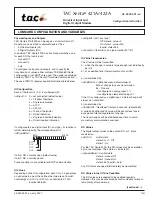
respectively. From these two numbers, a
fundamental fuel curve
is established. However, the
fundamental fuel curve only works on a thermodynamically linear engine. A thermodynamically linear
engine would have a torque curve that is a flat horizontal line from idle to redline. In reality, engines stray
from this straight line, sometimes dramatically, as in the case of motorcycle engines. To compensate for
non-linear fuel consumptions, a Volumetric Efficiency (VE) table is included in the software. The VE
table is based on RPM and MAP readings (like the Advance Table) to provide fuel injector pulse width
offsets for various loads and engine speeds that stray from linear.
Compensations…
Having a warmed-up engine running under steady-state conditions is all well and good, but in the
real world, we must deal with cold weather starting, engine accelerations and decelerations, etc. For these
scenarios, engines need fuel and spark
compensations
. The coolant temperature sensor (CLT) provides an
input for the
TECgt
to measure the engine temperature. Since cold engines need more fuel than hot
engines, tables are provided in the software to allow fuel flow increases as a function of engine
temperature. Other parameters related to the coolant temperature are cold starting (cranking) enrichments
and throttle movement enrichments when cold. A Manifold air temperature (MAT) sensor is mounted in
the intake tract to measure incoming air temperature. This reading is used to supply additional fuel for cold
weather, or to take away some fuel on hot days. The throttle position sensor (TPS) is used for functions
similar to the accelerator pump on a carburetor. Also, the TPS reading is used in the TPS-MAP Blend
routine, which is very useful for multiple throttle setups and radically-cammed engines.
Additional Features…
Once all the necessary input sensors are in place, and the software is tuned, the engine will run quite
well. However, to further refine the control of the engine, a few additional features are included. The idle
air control motor (IAC) is used to meter air into the engine at idle. This helps maintain a smooth idle,
regardless of operating conditions. It can also be used to increase the idle for cold temperatures, or air
conditioner activation. A fuel pump output is also included, which allows the user to turn on the fuel pump
relay for a set amount of time when the ignition is turned on. This primes the fuel system, and powers the
fuel pump once the engine is cranked and running. A tachometer output is included, which will drive most
modern tachometers, and a check engine output is included to keep track of failed engine sensors. A host
of other engine input and output options are included as well, and are outlined in other areas of this manual.
A.2. Pre-Installation Checklist
To perform a complete
TECgt
installation, the following items are required:
1.
TECgt
Computer
2. DFU(s)
3. Resistor Core Spark Plug Wires (see notes on Spark Plug Wires)
4.
TECgt
Wiring Harness w/ Power Harness
5. Windows-based PC-type Computer (see notes on Computer Requirements)
6. Serial Connector Cable (DB9) for PC
7. Crank Position Sensor (Magnetic Sensor)
8. 60 (-2) Tooth Crank Trigger Wheel or 120 (-4) Tooth Cam Trigger Wheel
9. Coolant Temperature Sensor (CLT)
10. Manifold Air Temperature Sensor (MAT)
11. Manifold Air Pressure Sensor (MAP)
12. Throttle Position Sensor (TPS)
13. Exhaust Gas Oxygen Sensor (EGO)
14. Idle Air Control Motor (IAC)
15. Knock Sensor (KNK)
______________________________________________________________________________________
TECgt Manual Version 2.0
- Page 10 -
©2008 Electromotive, Inc.











































